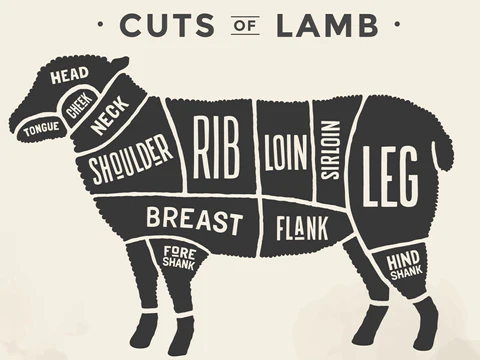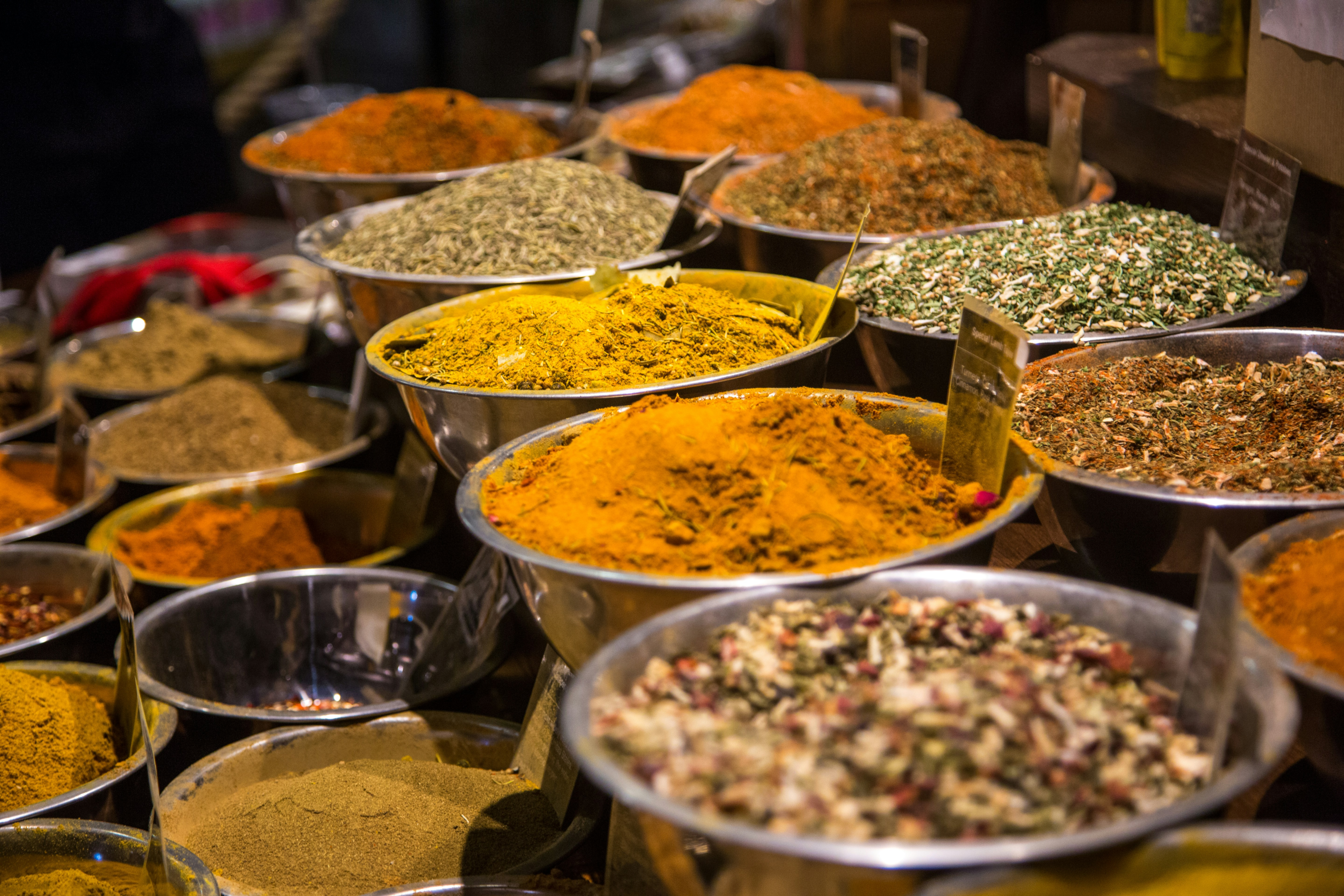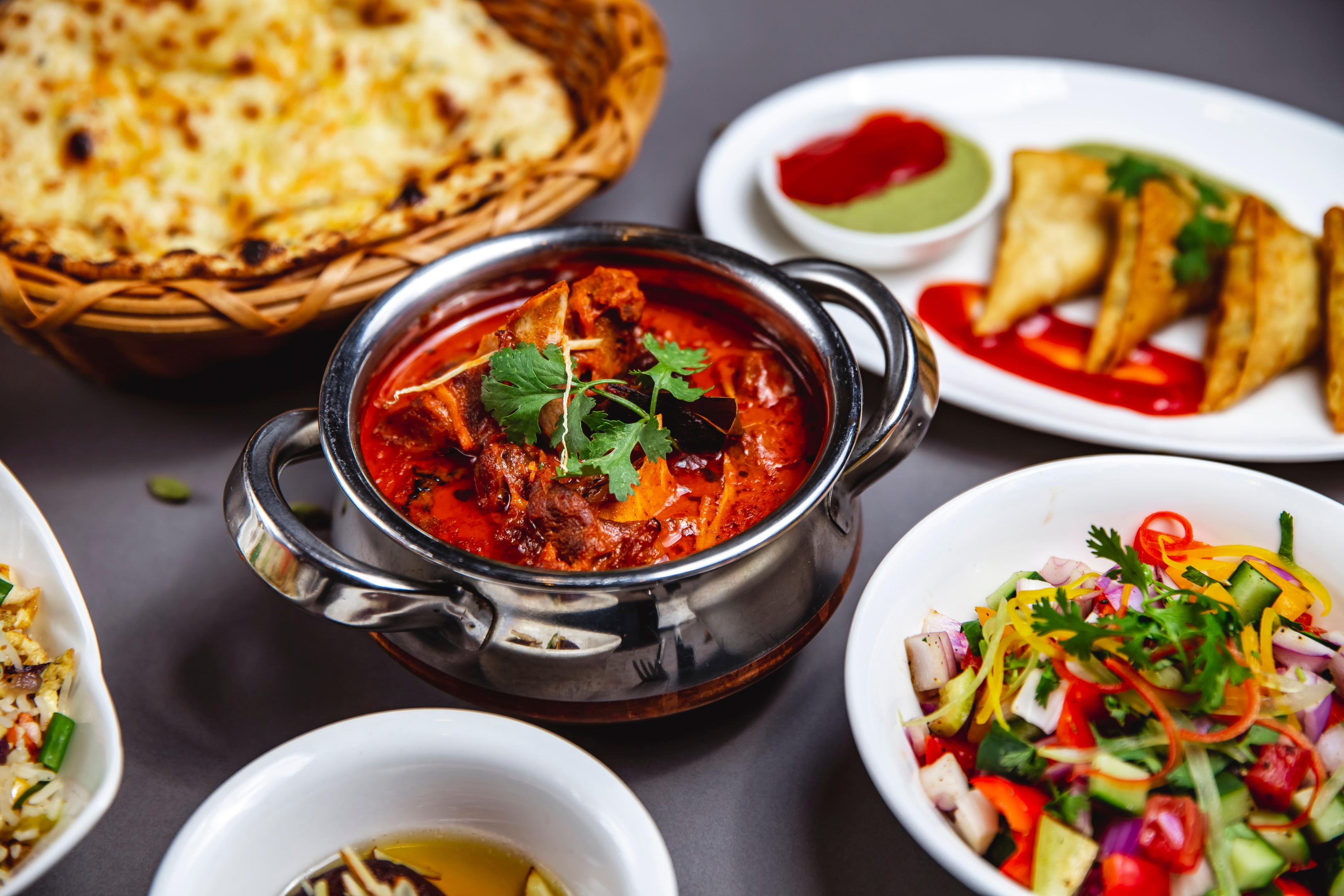Lamb Curry Recipes
The aromatic spices and rich flavourful sauces of lamb curries have made it a global takeaway favourite. A lamb curry covers a kaleidoscope of recipes from Lamb Rogan Josh to Balti, Lamb Bhuna, Dopiaza, Madras, Lamb Keema curry and an old-time classic, Lamb Biryani. Whether you prefer the creamy, mild kormas of Northern India or the fiery, coconut-infused dishes of Southern India, lamb curries cover a fascinating array of flavours and lend themselves beautifully to various cooking methods.
Come with us as we explore the rich and diverse world of lamb curry recipes and uncover the secrets of making the perfect lamb curry, celebrating its global appeal, and discovering why this dish remains a firm favourite worldwide.
Best Cut of Meat for Lamb Curry
The best cut of meat for a lamb curry depends on the cooking method used and the desired texture of the meat in the final dish. Generally, you want cuts that are well-marbled and can withstand long, slow cooking times to become tender and flavourful. Here are some of the best cuts for a lamb curry:
- Shoulder: Lamb shoulder is a slow cooker favourite and is ideal for curries. It has a good balance of fat and connective tissue, which breaks down beautifully during slow cooking, resulting in tender meat. You can buy lamb shoulder on the bone or as a boneless piece. Cooking it on the bone will add extra layers of flavour to any slow-cooked lamb curry.
- Leg: A leg of lamb is often used for curry recipes, especially when cut into chunks. It's leaner than the shoulder but still has enough connective tissue to become tender after cooking it low and slow. If using a leg of lamb, be careful not to overcook it, as it can become dry.
- Neck: The neck is a less common but excellent choice for curries. It has a lot of connective tissues and marbling, making it ideal for slow cooking. Neck fillets or neck slices can provide a rich flavour and succulent texture.
- Shank: Lamb shanks are another great option for an Indian curry. When cooked slowly, lamb shanks yield tender and flavoursome meat. They are often cooked whole in curries.

Why Choose Scotch Lamb?
When it comes to meat, quality matters and lamb doesn't come more highly acclaimed than premium quality Scotch Lamb.
Exceptional Quality:
Scotch Lamb is renowned for its superior quality and exceptional flavour. This distinctive taste is a result of the unique environment in which the lambs are reared. The lush, natural pastures and the clean, fresh air of Scotland contribute to the development of this highly prized meat.
Geographical Indication:
Scotch Lamb holds the coveted Protected Geographical Indication (PGI) status. This designation guarantees that the lamb is sourced from specific geographical areas in Scotland, ensuring consistent quality and authenticity. The PGI status also means that the lamb is produced according to stringent standards and practices, ensuring a high-quality product every single time.
Sustainable Farming Practices:
The production of Scotch Lamb is deeply connected with sustainable and natural farming practices. Scottish farmers are deeply committed to animal welfare and environmental stewardship.
Nutritional Value:
Lamb is a nutritious meat, rich in high-quality protein, vitamins and minerals. It also provides essential nutrients such as iron, zinc and B vitamins, making it a healthy addition to any diet.

The Basics of Lamb Curry
Lamb is a particularly well-suited meat for curries due to its unique characteristics. The rich, slightly gamey flavour of lamb complements the intensity and depth of spices commonly used in curry dishes. Unlike some other meats, lamb is robust enough to withstand strong spices creating a complex and satisfying taste profile. The higher fat content of lamb also helps it remain tender and moist during the long cooking processes. Its ability to absorb flavours makes it a versatile choice, easily adapting to a range of spice blends and cooking techniques, from slow-cooked lamb stews to quicker, more intense preparations.
Spices Commonly Used in Lamb Curry Recipes:
The beauty of lamb curry lies in its diverse range of ingredients and spices, each contributing to the dish's final flavour. Key spices in Indian cooking often include the following:
- Cumin and Coriander: Essential for their warm, earthy tones.
- Turmeric: Adds a vibrant colour and a subtle, bitter flavour.
- Garam Masala: A blend of ground spices like cinnamon, cloves and cardamom, contributing a sweet and spicy aroma.
- Ginger and Garlic: Provide a sharp, pungent base.
- Chilli Powder or Fresh Chilies: For heat.
- Fenugreek: Known for its slightly sweet, nutty flavour.
- Mustard Seeds: Common in some regional variants for their biting taste.
In addition to these spices, onions and tomatoes are foundational ingredients of Indian curries. Yoghurt or coconut milk is often added to create a creamy texture, and herbs like coriander, curry leaves or mint are used for freshness and balance.

A Simple Lamb Curry Recipe for Beginners:
This simple lamb curry recipe serves as a perfect tapestry for more complex and rich curry flavours.
Ingredients:
- 500g lamb, cut into chunks
- 2 tbsp vegetable oil
- 2 medium onions, finely chopped
- 3 cloves garlic, minced
- 1-inch piece fresh ginger, grated
- 1 tsp ground turmeric
- 1 tsp ground cumin
- 1 tsp ground coriander
- 1/2 tsp chilli powder (adjust to taste)
- 1 can (400g) chopped tomatoes
- 1 cup water or lamb stock
- Salt to taste
- Fresh coriander, for garnish
Instructions:
- Prepare the Lamb: Season the boneless lamb stew meat with salt.
- Sauté Onions, Garlic and Ginger: In a large pot, heat oil over medium heat. Add onions and cook until golden. Stir in garlic and ginger, cooking for another minute.
- Add the Spices: Mix in the spice mix of turmeric, cumin, coriander and chilli powder, stirring for about a minute until fragrant.
- Brown the Lamb: Add the lamb to the pot, browning it on all sides.
- Add Tomatoes and Simmer: Stir in the chopped tomatoes and water or stock. Bring to a boil, then reduce heat to low. Cover and simmer for about 1-1.5 hours, or until the tomato sauce has slightly thickened and the lamb is tender.
- Garnish and Serve: Check for seasoning, adding salt if needed. Garnish with fresh coriander. Serve hot with basmati rice or naan bread.

This simple recipe is a great starting point for anyone new to cooking lamb curry. It encapsulates the essential elements of the dish and it remains manageable for beginners. As your confidence grows, feel free to experiment with additional spices and ingredients to personalise your curry.
Regional Variations of Lamb Curry Recipes
When we think of curries, we are immediately transported to the magnificent continent of India where our love affair with curry recipes began. However, all across the globe, curry is enjoyed in various forms and delicious regional adaptations.
1. Indian Lamb Curry
Indian cuisine offers a remarkable diversity of lamb curries, each region boasting its unique take on this classic dish. In Northern India, particularly in Kashmir, curries like Rogan Josh feature aromatic spices and a rich, red colour from Kashmiri chillies. Moving to the Western state of Rajasthan, you will encounter Laal Maas, a fiery lamb curry with a deep, smoky flavour. In contrast, the Southern regions, like Kerala, present lamb curries with coconut milk and curry leaves, offering a tropical twist. Eastern India, including West Bengal, adds to the palette with subtler, yoghurt-based curries, often infused with mustard oil and spices like cumin and coriander. This regional diversity highlights the rich tapestry of flavours across India and lamb's versatility to stand up to a wide variety of spices.
Lamb Rogan Josh Recipe:
Ingredients:
- 500g lamb, cut into pieces
- 3 tbsp vegetable oil
- 2 medium onions, finely chopped
- 2 tsp Kashmiri chilli powder
- 1 tsp ground fennel
- 1/2 tsp ground ginger
- 1/4 tsp asafoetida(substitute with a mix of garlic and onion paste)
- 1 cinnamon stick
- 4 green cardamom pods
- 2 black cardamom pods
- 4 cloves
- 1 bay leaf
- 1 cup yogurt
- Salt to taste
- Water as needed
- Fresh coriander leaves, for garnish
Instructions:
- Heat oil in a heavy-bottomed pan. Add cinnamon, cardamom, cloves, bay leaf and asafoetida. Sauté for a minute.
- Add onions and cook until golden. Mix in the lamb pieces and brown them.
- Stir in Kashmiri chilli powder, ground fennel, ground ginger and salt. Cook for a few minutes.
- Beat the yoghurt and gradually add it to the pot, stirring continuously.
- Add enough water to cover the lamb, bring to a boil, then simmer covered and slow cook until the lamb is tender, usually about 1-1.5 hours.
- Garnish with fresh coriander and serve with rice or naan.
2. Middle Eastern Lamb Curry
Middle Eastern lamb curries are known for their aromatic and subtly spiced profiles. The use of ingredients like pomegranate molasses, apricots, saffron and a range of warming spices like cumin, cinnamon and nutmeg imparts a sweet, tangy and deep flavour to these dishes. These curries often involve slow-cooking techniques, allowing the flavours to meld beautifully. Lamb is a central ingredient in Middle Eastern cuisine, revered for its rich taste that perfectly complements the regional spices, sweet dried fruits and herbs.
Lamb Tagine Recipe:
Ingredients:
- 500g lamb, cut into chunks
- 2 tbsp olive oil
- 1 large onion, chopped
- 3 cloves garlic, minced
- 1 tsp ground cumin
- 1 tsp ground cinnamon
- 1/2 tsp ground turmeric
- 1/4 tsp ground ginger
- 1 cup chicken or lamb stock
- 1 can (400g) chickpeas, drained
- 1 cup dried apricots, chopped
- Salt and pepper to taste
- Fresh parsley, for garnish
Instructions:
- In a tagine, Dutch oven or heavy pot, heat olive oil. Add onion and garlic, cooking until softened.
- Add lamb and brown it. Stir in cumin, cinnamon, turmeric and ginger.
- Pour in the stock and bring to a boil. Reduce heat, cover and simmer for about 1 hour.
- Add chickpeas and apricots. Cook for another 30 minutes or until the lamb is tender.
- Season with salt and pepper. Garnish with fresh parsley and serve with couscous or flatbread.
3. European Influences
In Europe, lamb curry takes on a unique form, blending traditional Indian spices with local ingredients and cooking techniques. European adaptations often involve milder flavours and the incorporation of vegetables common in the region, like bell peppers, tomatoes and root vegetables. These curries might also see the inclusion of cream or local cheeses, offering a richer, more rounded flavour profile.
Curry with a European Twist:
Ingredients:
- 500g lamb, cut into cubes
- 2 tbsp olive oil
- 1 large onion, chopped
- 2 cloves garlic, minced
- 1 red bell pepper, chopped
- 1 carrot, diced
- 2 tsp mild curry powder
- 1 can (400g) chopped tomatoes
- 1/2 cup cream
- Salt and pepper to taste
- Fresh parsley or thyme, for garnish
Instructions:
- Heat olive oil in a pan. Sauté onions, garlic, bell pepper and carrot until soft.
- Add the lamb and brown it. Sprinkle with curry powder and cook for a minute.
- Pour in the tomatoes and bring to a simmer. Cover and cook for about 1 hour or until the lamb is tender.
- Stir in the cream and season with salt and pepper.
- Garnish with fresh parsley or thyme and serve with boiled potatoes or rice.

These regional variations of lamb curry recipes demonstrate the universal appeal of this dish, with each region adding its unique touch to the recipe. From the spices of Indian cuisine to the aromatic delicacies of the Middle East and the comforting adaptations in Europe, lamb curry truly is a dish without borders.
Tips for Making Lamb Curry Healthier Without Sacrificing Flavour
Creating a healthier version of lamb curry without losing its rich flavour is all about smart substitutions and cooking techniques:
- Lean Cuts of Lamb: Opt for leaner cuts of lamb, trimming any visible fat, to reduce the overall fat content of the curry.
- Increase Vegetables: Bulk up the curry with a variety of vegetables like spinach, bell peppers and cauliflower. This not only adds nutrients but also enhances the flavour and texture.
- Use Low-Fat Coconut Milk: In recipes calling for coconut milk, choose the low-fat version or substitute it with Greek yoghurt for a creamy texture without the extra calories.
- Reduce Oil: Minimise the amount of oil used for sautéing. Non-stick cookware can be particularly helpful in reducing the need for excess oil.
- Spice it Up: Don’t skimp on the spices. Spices add a depth of flavour without adding calories. Additionally, some spices, like turmeric and ginger, have anti-inflammatory properties.
- Serve with Whole Grains: Instead of white rice or bread, serve your curry with whole grains like brown rice, quinoa, or whole wheat naan to increase the fibre content of your meal.
Tips on Marinating Lamb for Optimal Flavour
Marinating lamb not only infuses the meat with flavour but also tenderises it. Here are some top tips for the best results:
- Use Acidic Ingredients: Ingredients like yoghurt, lemon juice or vinegar help in tenderising the lamb by breaking down its proteins.
- Include Spices and Herbs: Spices like cumin, coriander and garlic add depth, while herbs like rosemary and thyme offer freshness.
- Time: Ideally, lamb should be marinated for at least a few hours, if not overnight, to allow the flavours to infuse deeply.
- Refrigeration: Always marinate lamb or any other meats in the refrigerator to avoid bacterial growth.
- Avoid Metal Containers: Use glass or plastic containers for marinating, as metal can react with acidic ingredients.
Serving and Pairing Suggestions
There are a whole host of delicious side dishes that complement curries beautifully, and you can be as creative as you like, but these are some of the old-time favourites:
- Rice: Basmati or jasmine rice pairs well with lamb curry, as their subtle flavours complement the richness of the curry without overpowering it. Coconut rice or various versions of pilau rice are also popular options.
- Bread: Flatbreads like naan, roti or flaky paratha are perfect for scooping up the curry. A crusty loaf of bread can also be a delightful accompaniment.
- Vegetables: Serve with steamed or roasted vegetables like carrots, broccoli or cauliflower to add a nutritious balance to the meal. Salad sides are also a popular takeaway choice.
- Wine Pairing: A full-bodied red wine like Syrah or Malbec can complement the richness of lamb curry perfectly. And if you prefer white, choose a wine with enough acidity to cut through the richness, such as Riesling or Sauvignon Blanc.
- Condiments: Offer chutneys, pickles and raita (yoghurt, cucumber and mint-based sauce) to add additional flavours and textures.

Remember, the key to a great lamb curry lies not just in the ingredients and recipe but also in the cooking techniques and how it is served.
Creative Ideas for Leftover Lamb Curry
Leftover lamb curry can be a treasure trove for creative and delicious meals. Here are some ideas for some amazing quick dinners to enjoy and to avoid food waste:
- Stuffed Parathas: Use the leftover curry as a filling for parathas. Shred the lamb and mix it with the sauce for a moist filling.
- Curry Pies: Fill pie crusts with the curry for a delightful fusion of Indian and Western cuisine.
- Lamb Curry Sliders: Shred the lamb, mix it with some of the curry sauce, and serve on mini buns for a unique twist on sliders.
- Lamb Curry Pizza: Spread the curry over pizza dough, top with cheese, and bake for a fusion pizza.
- Wraps and Burritos: Fill wraps or burritos with rice, leftover lamb curry, some fresh lettuce, and a dollop of yoghurt for a quick meal.
- Lamb Curry Tacos: Use shredded lamb curry in tacos, topped with fresh salsa, sour cream and cheese for a tasty treat.
- Shepherd's Pie: Layer the bottom of a baking dish with lamb curry, top with mashed potatoes, and bake until golden for a twist on the classic shepherd's pie.
Where Can I Buy Scotch Lamb Near Me?
To prepare the perfect lamb curry, you need quality star ingredients such as premium quality Scotch Lamb.
The good news is that with the help of our user-friendly map, getting your hands on this quality produce couldn't be easier. Just enter your postcode, and the map will guide you to your nearest Scotch meat supplier and you'll be cooking up a storm in no time!
Supporting Scottish Farmers
But more than that, when you purchase Scotch Lamb, you are also investing in the hard work of a community of passionate Scottish farmers who produce some of the finest quality meat in the world. Their commitment to traditional farming practices, sustainability and environmental stewardship is what distinguishes the Scottish red meat industry on a global stage and makes every cut of meat special.
What's The Scotch Difference?
Let us take you on a journey into what makes Scotch Beef, Scotch Lamb and Specially Selected Pork so special, and how we produce such high-quality meat renowned and enjoyed worldwide.


- © MakeitScotch 2025
- Cookies
- Privacy
- Terms of Use
Site by Art Department
